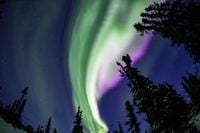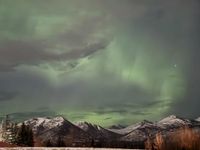Many across the United States are eagerly anticipating a natural spectacle as geomagnetic storms are predicted for March 25-26, 2025, promising the chance to see the stunning northern lights, or aurora borealis, in regions across the Midwest and northern states. These expectations come in light of recent solar activity characterized by coronal mass ejections and coronal holes, as reported by the National Oceanic and Atmospheric Administration (NOAA).
The best opportunity to witness this breathtaking display of nature is expected between 10 p.m. and 2 a.m. on both nights, contingent upon weather conditions and light pollution. Forecasters note that those closest to the Canadian border will have the highest chances of spotting the aurora.
The solar phenomena responsible for this extraordinary potential light show include coronal mass ejections (CME), which occur when the sun releases plasma that interacts with the Earth’s magnetic field. This interaction can lead to geomagnetic storms that create the vibrant displays of light in the sky. NASA likens these events to a “sun burp,” explaining that during a CME, the sun expels sizable bubbles of electrified gas that travel at high speeds through space, ultimately resulting in stunning displays as the particles collide with gases in the atmosphere, creating vivid colors.
The NOAA predicts that the current solar maximum, which has been reached in 2024, will create increased opportunities to see the auroras in the coming months. Such predictions are validated by an earlier alert from NOAA’s Space Weather Prediction Center, which issued a warning of moderate geomagnetic storm conditions, or G2 level, for Tuesday night, and this could continue into the following day.
According to the Space Weather Prediction Center (SWPC), which detected a coronal hole high-speed stream (CH HSS) on March 21, 2025, regions such as Alaska, northern Montana, North Dakota, South Dakota, Wisconsin, and other border states could expect the best views on March 25. The SWPC foresees that the geomagnetic storms could reach their peak intensity around 11 p.m. ET. It should be noted, however, that while the auroras are most visible with minimal light interference, urban dwellers might need to venture to darker areas to get the best view.
Residents in states such as Washington, Idaho, Minnesota, Michigan, Vermont, and Maine will also have the potential to witness the northern lights, although the likelihood decreases as one moves further south. For those unable to see the northern lights with the naked eye, using a smartphone camera may provide a better chance to capture the faint colors.
As excitement builds, meteorologists advise skywatchers to keep their expectations realistic. While there is a chance to see the aurora borealis, the visibility can be highly contingent on local weather conditions and light interference from cities, making urban viewing challenging. Therefore, it's important for viewers to check their local forecasts ahead of the event.
In summary, those prepared to brave the night sky on March 25-26 may view one of nature's most awe-inspiring spectacles if conditions permit. This event showcases not only the beauty of our natural world but also serves as yet another reminder of the sun's powerful influence on Earth.
For those interested in tracking the latest updates about solar activity, tapping into the resources provided by NOAA and NASA could enhance the experience, offering insights into the best times and areas to observe this dazzling display. Keeping an eye on space weather reports can be valuable for maximizing the chances of experiencing the aurora borealis during this rare opportunity.


